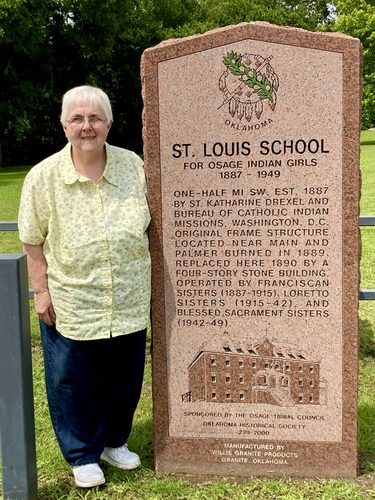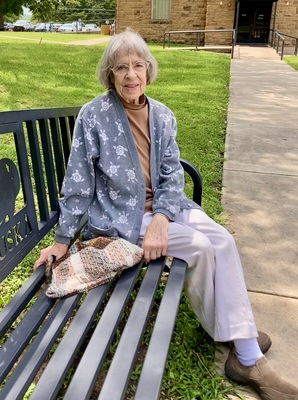Following the Osage Trail
Posted on October 1, 2023, by Annie Stevens CoL

Photo courtesy of Annie Stevens
Inspired by Libby Comeaux’s Loretto Roots research, Barbara Ann Barbato and I traveled across Missouri in June, heading west to Kansas and Oklahoma where Loretto taught Osage children in the 19th and 20th centuries. We visited museums, churches and people who had lived in the area, learning how stories of Native Americans and European Americans have carried down generation to generation.
At the visitor center in Cuba, Mo., we learned about the Osage trading trail, which later became historic U.S. Route 66. A group of figures representing an Osage family can be seen from both directions of the highway. The artist worked in collaboration with the Osage Cultural Center in creating the figures. In downtown Cuba, a series of murals show the history of the area, including the Osage presence which had included all of Missouri in the early 1800s.
Tribal leaders visited St. Louis in the summer of 1824, asking the Jesuits for teachers for their sons, and made the acquaintance of Rev. Charles Nerinckx, who offered Osage girls a place in the new Loretto school in Perryville, Mo. His death on Aug. 12 interrupted that plan, but in 1847, Sisters of Loretto went to Osage Mission, Kan., where they fulfilled his intention.
In St. Paul, Kan., on the site of the original mission school, we visited Osage Mission Neosho County Museum. We met Edward Born, president of the historical society, and learned that he is a descendant of Cornelius Rhodes, one of the brothers of Mary and Ann Rhodes! He pointed us to many displays, pictures and artifacts associated with Loretto, during both the Osage mission era (1847-1870) and the St. Ann’s Academy years (1870-1895) after the Osage ceded their land and moved to Oklahoma. He also directed us to St. Francis Hieronymo Catholic Church across the road and to the cemetery nearby where we found the Sisters of Loretto buried close to a monument the Osage had recently dedicated to one of their tribal members who was a Union soldier during the Civil War.
Following roads through wheat fields, we traveled south to Pawhuska, Okla. We visited the Osage Nation Museum, the oldest tribally-governed museum in the U.S. Interior photography is not allowed, but exhibits and other cultural videos are available at www.osageculture.com. On the western edge of the city, we saw the monument to the St. Louis School for Osage Indian Girls where Loretto taught 1915- 1942. After the school closed in 1949, the original building served as a home for elders. In the center of the city, we saw the Osage Cultural Center, where language lessons are taught, instilling Osage children with full understanding of their heritage.
We reflected on all that we had seen on this three-day trip, recalling another plaque in Pawhuska that described a deep intercultural connection the Osage established with a city in France:
“In November 1829, three Osages arrived in Montauban, the Occitan region of France. Little Chief, Big Soldier and Hawk Woman crossed the Old Bridge, received help from Bishop Dubourg, and with the generosity of the people of Montauban they were able to return to the Osage. In 1989, the friendship between the Occitan of Montauban and the Osage was revived. The cities of Montauban and Pawhuska signed a twinning agreement in 1999 so that today we often see Osages in Montauban and Occitans in Pawhuska. With this monument we celebrate that people across borders, mountains and oceans can unite, respecting their differences in ties of sincere friendship. Today, July 24, 2013, we hereby dedicate this monument to the many enhanced exchanges that encourage us to retain and maintain our distinct cultures, languages and value systems. The Earth does not belong to Man; Man belongs to the Earth.”

Photo by Annie Stevens
